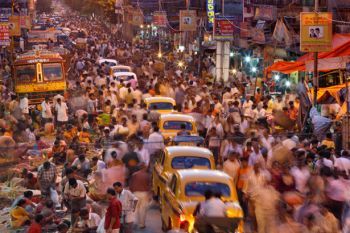
Publisher:
Bonnie King
CONTACT:
Newsroom@Salem-news.com
Advertising:
Adsales@Salem-news.com

~Truth~
~Justice~
~Peace~
TJP
Jun-17-2013 19:57

 TweetFollow @OregonNews
TweetFollow @OregonNews
3 India's at War: Sensex India, Maoist India, and Bharat
Rajiv Malhotra Special to Salem-News.comThis article summarises some key kurukshetras within India where these forces are at war with one another.
 Courtesy: deladream.com |
(PRINCETON, NJ) - In order to understand India’s present dynamics, it is helpful to think of three competing forces at work internally, each with its distinct support bases and strategic ambitions. Of these forces, Sensex India and Bharat are pro-nation forces even though they fight each other, while Breaking India opposes the unity of India. This article summarises some key kurukshetras within India where these forces are at war with one another. I want to make it politically correct to discuss this in the mainstream.
I have coined the term Sensex India to refer to the western-style institutionally organised economy and lifestyle. This includes all those Indians who relate to the corporate sector as investors, producers or consumers. The major metros and second-tier towns are now largely taken over by this segment, and belonging to it is considered synonymous with being “modern”. The proportion of Indians who belonged to this category during colonial rule was tiny, but has mushroomed after independence, and especially in the past decade of India’s “globalisation”. Sensex India uses Western models that are based on centralised governance, extreme materialism, greed and short-term thinking in matters of environment and sustainability. It continues the legacy of cultural disruption that was started by European colonialists, even though now it is brown-skinned Indians performing the white man’s roles.
The Indians leading this tend to be directly or indirectly integrated with their fellow western elitists, not only in business transactions but also in media, lifestyle, literature, fashions, brands, etc. What is being touted as globalisation is largely the westernisation of the globe. All too often, cricket, Bollywood and a few traditional symbols (carried forward from Bharat, discussed below) comprise the shallow sense of Indian identity among this class. They crave mimicry of the west. A person’s westernisation has become the measure of superiority over his fellow Indians.
While Sensex India seeks to unify India using top-down development, there are opposing centrifugal forces tearing it apart. I have discussed these in numerous talks and in my book, Breaking India. These fissiparous forces include regional ethnic identities, foreign religious nexuses, and so forth. Because I have discussed many of them elsewhere, in this brief article I shall focus on one such divisive force that I refer to as Maoist India, the rebellious insurrections that confront approximately one-third of India’s districts, according to government sources.
Has the western school of thought become synonymous with progress?
In order to understand India’s present dynamics, it is helpful to think of three competing forces at work internally, each with its distinct support bases and strategic ambitions. Of these forces, Sensex India and Bharat are pro-nation forces even though they fight each other, while Breaking India opposes the unity of India. This article summarises some key kurukshetras within India where these forces are at war with one another. I want to make it politically correct to discuss this in the mainstream.
I have coined the term Sensex India to refer to the western-style institutionally organised economy and lifestyle. This includes all those Indians who relate to the corporate sector as investors, producers or consumers. The major metros and second-tier towns are now largely taken over by this segment, and belonging to it is considered synonymous with being “modern”. The proportion of Indians who belonged to this category during colonial rule was tiny, but has mushroomed after independence, and especially in the past decade of India’s “globalisation”. Sensex India uses Western models that are based on centralised governance, extreme materialism, greed and short-term thinking in matters of environment and sustainability. It continues the legacy of cultural disruption that was started by European colonialists, even though now it is brown-skinned Indians performing the white man’s roles.
The Indians leading this tend to be directly or indirectly integrated with their fellow western elitists, not only in business transactions but also in media, lifestyle, literature, fashions, brands, etc. What is being touted as globalisation is largely the westernisation of the globe. All too often, cricket, Bollywood and a few traditional symbols (carried forward from Bharat, discussed below) comprise the shallow sense of Indian identity among this class. They crave mimicry of the west. A person’s westernisation has become the measure of superiority over his fellow Indians.
 Can the Maoist India ever be placated? AFP |
While Sensex India seeks to unify India using top-down development, there are opposing centrifugal forces tearing it apart. I have discussed these in numerous talks and in my book, Breaking India. These fissiparous forces include regional ethnic identities, foreign religious nexuses, and so forth. Because I have discussed many of them elsewhere, in this brief article I shall focus on one such divisive force that I refer to as Maoist India, the rebellious insurrections that confront approximately one-third of India’s districts, according to government sources.
There are many disparate revolts against Sensex India, being provoked on the grounds of feeling exploited and marginalised. Maoist Indians allege that they are victims of cultural genocide which is being carried out behind the smokescreen of “progress”. While Sensex India is run top-down with elitist centralised structures and mostly English-speaking governance, Maoist India is grassroots and bottom-up. Here the local languages predominate and the support base is very grounded and bonded with the native soil of a given geographical locality. This means that Maoist India is not one unified movement, but several disparate movements spread across the country, each fighting a local war against local authorities. Often the local police or even symbolic presence of “India” is used as a target to unleash their frustrations.
There are growing alliances emerging across the different geographies, including cells of revolt in neighboring countries. Some of the leaders of these movements include well-educated modern Indians who have turned into revolutionaries, drawing inspiration from similar leftist movements in other parts of the world. China’s Chairman Mao is commonly used as the mascot and political ideologue; hence the term Maoists is used to refer to all such movements.
Their prime enemy is Sensex India and the Indian government seen as its guardian. Many local battles have erupted over the appropriation of lands and natural resources by Sensex India and its foreign collaborators. The Hollywood movie, Avatar, depicts a fictional account of the capitalist exploitation of natives, which resembles many of the issues at stake here. When I saw that movie, I was also imagining the story of the genocide of Native Americans by Europeans after the so-called “discovery” by Columbus (which was really a conquest of the cruellest kind).
The origin of this clash between western-style “civilisation” and the natives of the soil had its origins long ago. It crystallised in legal terms when the British classified many local jatis (traditional communities) that resisted colonial presence as “criminal tribes”. The notorious Criminal Tribes Act of 1871 was later extended and further consolidated in 1876, 1911 and 1924. Even though India repealed it after independence, many structures that it produced have endured, such as the category “tribe” which is a derogatory western term. In the terminology of Bharat, all these so-called tribes are jatis. The only difference is that these jatis were too different from western norms and resisted (often with violence) the attempts to encroach into their territories and sacred spaces.
The thugs were one such jati that became infamous. They were especially dangerous for the British rulers of India, because they organised attacks against colonial presence wherever they found such a foreign presence to be vulnerable. For instance, the thugs were opposed to the very large scale deforestation of their lands which the British carried out in order to supply wood to Britain and to their own projects in India. The criminalisation of this jati was so successful that their name has entered the global lexicon as synonymous with crookedness and criminality in general. It is analogous to a pejorative racist term like “nigger” except that there is virtually no resistance against its use because the thugs got exterminated by British edict.
This pejorative mindset is prevalent in the attitude of Sensex Indians towards “tribals”; it is a view through their colonised lenses. It sees the native jatis as “occupiers” of valuable lands that need to be exploited in the name of progress and civilisation. This is the exact same story as the whites who called themselves “settlers” of the American landscape, after making it “empty” of the natives by various means of genocide.
Bharat is the term that refers to traditional India. Whether one thinks of pre-colonial Indian native society as good or bad, there is no doubt that such a society has survived for a very long time, and that many pockets of India still live in traditional lifestyles deeper than mere symbolism and ornamentalism. Today, Bharat has been invaded by both Sensex India and Maoist India, albeit using different reasons and different methods. The Sensex Indians are following imported right-wing capitalist models that are said to have emerged from the Protestant Ethic in the West, and they are frantically “developing” the civilisation of Bharat by westernising it. The Maoist Indians are following imported left-wing models to redress their grievances. Each attacks Bharat with its own imported theories, and each offers its own kind of promise for a better society. The important thing is that both are foreign nexuses based ideologies, and both are tearing Bharat apart. I predict that neither Sensex India nor Maoist India will score an absolute victory, but that this war will break up India sooner than most Indians are willing to admit.
Special thanks to First Post
http://www.firstpost.com/blogs/3-indias-at-war-sensex-india-maoist-india-and-bharat-876705.html
 |
 |
 |
Articles for June 16, 2013 | Articles for June 17, 2013 | Articles for June 18, 2013
Quick Links
DINING
Willamette UniversityGoudy Commons Cafe
Dine on the Queen
Willamette Queen Sternwheeler
MUST SEE SALEM
Oregon Capitol ToursCapitol History Gateway
Willamette River Ride
Willamette Queen Sternwheeler
Historic Home Tours:
Deepwood Museum
The Bush House
Gaiety Hollow Garden
AUCTIONS - APPRAISALS
Auction Masters & AppraisalsCONSTRUCTION SERVICES
Roofing and ContractingSheridan, Ore.
ONLINE SHOPPING
Special Occasion DressesAdvertise with Salem-News
Contact:AdSales@Salem-News.com

googlec507860f6901db00.html



Terms of Service | Privacy Policy
All comments and messages are approved by people and self promotional links or unacceptable comments are denied.
[Return to Top]
©2025 Salem-News.com. All opinions expressed in this article are those of the author and do not necessarily reflect those of Salem-News.com.